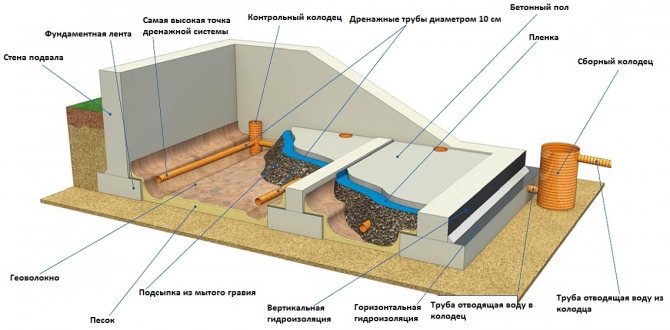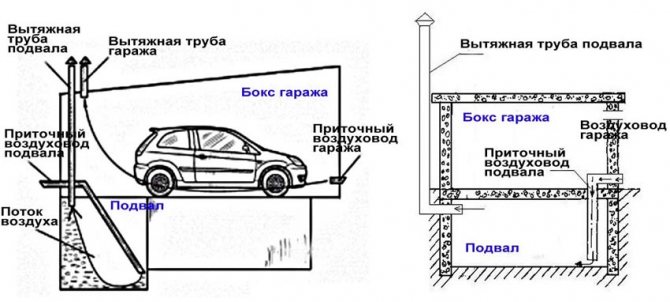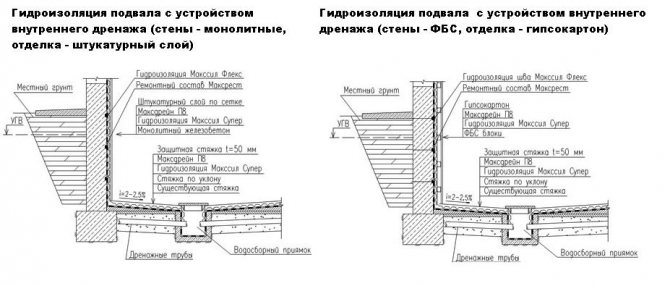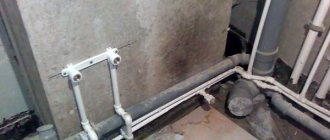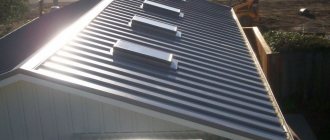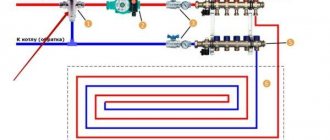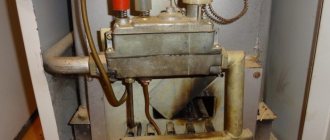Setting up a basement in a garage is common. It is very convenient, practical, while a fairly decent volume is formed, which can be used as a place for storing things, crops, conservation. As a rule, it is a basement and is used as a storage for food and vegetables. In this regard, there is an additional need for high-quality ventilation of both the basement itself and the garage space as a whole. Ventilation in the basement of the garage is a simple, reliable way to organize the microclimate necessary for these premises.
Features of the basement device in the garage
- The garage basement is a structure isolated from the external environment. The entrance is located inside the garage.
- There are no sources of natural air flow at all.
- Given the depth at which it is equipped, we can say that it is warm enough there in winter. This inevitably causes condensation to build up.
- Through the entrance opening, moisture penetrates into the garage room, creates excess moisture there, which affects the structure in the most negative way.
- The arrangement of the basement with ventilation passes through or with the help of the garage space.
- Placing a basement in the ground requires a special hydro- and heat-insulating finish of internal surfaces (impregnation of the floor, walls, special materials, insulation of floors with mineral wool).
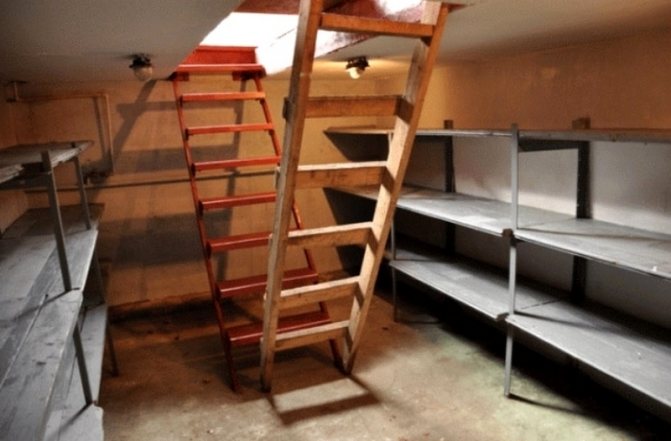
Installing a stove in a regular place
We have assembled the stove stove, now we will start installing it. For this, the base is being prepared. The stove cannot be installed on earthen floors - it will gradually push them through. It is necessary to pour a concrete screed on which the oven itself will stand. If ready-made concrete floors are available, there will be one less problem in the installation procedure. In the case of installing a potbelly stove on wooden floors, it is necessary to lay a sheet of metal 1-2 mm thick on them. The same sheet should be located in front of the firebox - this will prevent fire if the coals accidentally fall out.


It is recommended to install a protective brick jacket. It prevents burns and ensures even heat dissipation.
To install the potbelly stove in the garage as correctly as possible, use the following recommendation - step back from the nearest walls 50-60 cm. Thus, you will avoid overheating and reduce heat losses. The recommendation is valid for brick, concrete and timber walls. In the case of wood, it becomes mandatory (the distance to the wooden wall should be 1 meter, it is recommended to cover them with bricks or sheathing with asbestos). You can also sheathe the walls with metal to reflect heat. The distance to vehicles is at least 1.5 meters (preferably 2 meters).
Read next: Engine sound in subwoofer
Heating the garage with a potbelly stove will be more effective if it is located not at the garage door, but at the opposite wall. We pay special attention to the vent - make sure that there is an opening in the garage for outside air. Otherwise, the oxygen level in the room will be too low.
Why do you need basement ventilation in a garage?
To preserve a favorable microenvironment of the basement, it is extremely necessary to constantly efficiently ventilate it, which is due to a number of reasons:
- In the cold season, the ground around the basement does not freeze, its temperature remains positive, warming up the air in the room. This creates a high level of humidity, which contributes to the constant accumulation of condensation.
- Dampness adversely affects wooden elements, parts of the basement, is a favorable environment for the appearance of mold, fungus, pathogens, moisture-loving insects. This is especially dangerous if the basement is to be used as storage for crops.
- It is also highly undesirable for excess moisture to enter the garage, where it will settle on metal surfaces, causing corrosion (in particular of a car).
- If groundwater passes nearby, high humidity will persist for a long time. Therefore, the basement must be dried constantly.
- In addition, it is necessary to observe a certain temperature regime, when coolness is required in summer, and an acceptable level of heat in winter (when it comes to storing vegetables, preserving).
- When installing a basement under the garage, there is a high probability of the penetration of toxic substances, fuel vapors, exhaust gases, etc. Let there be a small number of them, nevertheless this is not at all desirable.
Considering the above factors, we can say with confidence that proper ventilation of the garage with a basement is simply necessary. In this case, the garage itself should also be well ventilated.
Ventilation in the office. How to organize, standards. All the fun about ventilation!
What makes the cellar in the garage damp
Initially, the basement design is determined based on the proximity of the groundwater table. It is desirable that they do not reach the bottom of the cellar by about 0.5 m. The groundwater level should be fixed during the periods of its maximum value: in spring, during floods, or in autumn, during the period of prolonged rains. Of course, it is better to install the cellar in a high and dry place, which reduces the amount of waterproofing work. However, in general, the most comfortable location for a basement does not meet all the requirements of an effective cellar structure, so you have to adjust the building with various additional measures.
For example, some types of soil, such as clay, sandy loam and loam, tend to swell at low temperatures, destroying the basement foundation. In this case, it is necessary to replace such soils with sandy ones. In addition, a cellar built in a dense clay soil is constantly exposed to stagnant water that accumulates on the back of the pit.
< Note> Stagnant water is one of the main causes of dampness in a garage cellar.
To get rid of the accumulation of stagnant water and, accordingly, from dampness in the cellar, it is necessary to ensure the removal of atmospheric and melt water using a water supply ditch, ring drainage. And the walls of the cellar must be as strong as possible in order to withstand the hydrostatic pressure of stagnant water.
If the basement ceiling is not insulated enough, then condensation and dripping may form on it.
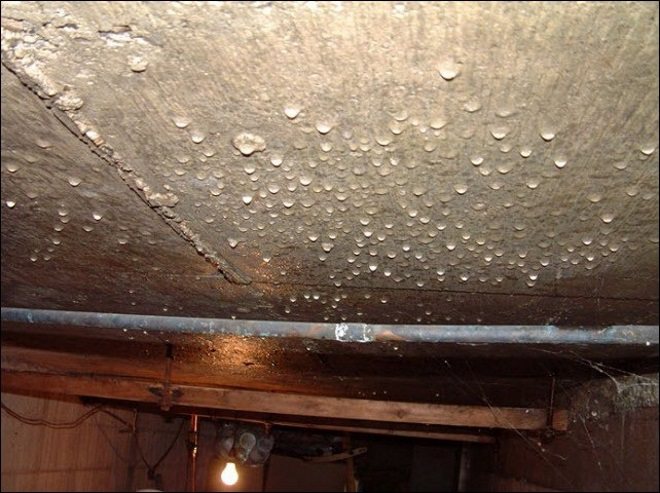

Condensation on the ceiling
The reason for the increased moisture in the cellar, of course, is also the incorrect technology of roofing and the blind area of the garage. The problem is exacerbated in the autumn-spring period, when against the background of rising groundwater and the amount of rain, it is extremely difficult to avoid flooding the basement. And with the approach of the harvest, we urgently have to solve the unpleasant question of how to dry the cellar in the garage quickly, efficiently and for a long time.
Naturally, the issue of sufficient drying of the garage should be decided even at the stage of construction work of the garage with a cellar, it is much easier than taking additional measures to eliminate moisture in an already finished building. It is extremely difficult to get rid of excess moisture in a wooden structure, which is especially sensitive to moisture, up to destruction.
Natural ventilation of the basement in the garage
Natural ventilation in the basement of the garage is the simplest, least costly of all possible methods.This ventilation option differs mainly in disadvantages, rather than advantages. But under certain conditions it can be a pretty good solution for organizing air exchange processes in an underground storage.


Pros:
- Ease of installation, simple principle of operation based on the laws of physics.
- Affordable cost.
- Minimum installation effort.
Minuses:
- The natural air flow may not be enough for good ventilation of the basement space. Especially if it constantly collects moisture from the ground.
- In summer, when the air temperature is high, the draft weakens, sometimes it completely stops, the air circulation stops.
- Great dependence on atmospheric conditions of the environment.
- Air exchange failure due to strong wind from the wrong side.
Natural ventilation can be effective when:
- the basement is arranged with good thermal and waterproofing;
- condensate does not accumulate in large volumes;
- the soil around the structure is not saturated with groundwater, which means that there is no excess moisture inside it;
- the intake of the supply duct is located inside the outer wall of the garage, and not in the ceiling.
Forced ventilation in the basement of the garage
A forced ventilation device in the basement of the garage is the best option, especially for a crop storage.
It is the organization of air exchange using supply / exhaust electrical mechanisms. They are placed inside ventilation ducts (duct fans), openings (axial, centrifugal fans). In this case, it is necessary to observe electrical safety during installation. After all, the building is with a high level of humidity. It must be properly waterproofed; it is also recommended to insulate all wiring.


Benefits mechanical ventilation for the basement space:
- The constant change of air flows normalizes the humidity level. Dampness does not stagnate, it is removed outside.
- The frequency of changing the air in the basement space is in accordance with the established sanitary standards.
- The temperature regime corresponds to acceptable indicators.
- The microenvironment is normalized, contributing to the long storage of the crop, preventing the appearance of mold, fungus, rot, insects (when it comes to using the basement as a cellar).
- Penetrating vapors of chemicals, toxic gases, exhaust products are discharged through the exhaust duct, without lingering inside the basement space.
- The operating time is regulated by a timer.
Disadvantages:
- Cost of equipment.
- The cost of electricity from which the mechanisms work.
- Installation of the ventilation system becomes more complicated.
Installation of forced ventilation
Forced circulation of air masses is provided by fans. The installation method of this system is similar to the first, however, after installing the pipes, it is necessary to install the fans. With this equipment, you can control the air exchange in the cellar. If you want to ensure air circulation not only in the basement, but also in the garage itself, the fan must be installed at the level of the garage ceiling. In such a situation, air will be drawn from two rooms.
The installation of a heating lamp in the pipe will help to increase the level of the hood, the air exchange will be increased due to the heating of the air masses.
Combined ventilation system for the basement of the garage
The combined option also allows you to organize good ventilation in the basement of the garage, while saving on the supply fan. Here the ventilation mechanism is installed inside the exhaust opening / duct, forming a mixed type of air circulation with natural ventilation.
To connect the fan, a well-insulated power supply is required.Principle of operation - due to the increase in the outflow of exhaust air, the thrust increases, and, accordingly, the supply air is supplied in a large volume.
Advantages:
- Good ventilation rates of the storage facility.
- The removal of stagnant air is increased
- The ability to set the time intervals for the fan (if there is a timer).
- Not the most difficult installation option.
Disadvantages:
- Electricity costs.
- Exhaust equipment cost.
How to properly ventilate the basement
Consider several options for how to make ventilation in a basement storage with your own hands. The methods given below are the installation of a natural ventilation system, which can easily become forced or combined after the additional installation of exhaust / supply fans.
Garage + basement Very often, the ventilation ducts from the storage pass through the garage room and are taken out of it. There are two options for placing the air ducts here.
Option 1. Do-it-yourself direct air supply outside the garage.
- Determine where the ventilation ducts will be located. The most effective option is opposite corners so that the incoming air covers the entire volume of the space as much as possible. In the outer wall of the building, the opening of the pipe outlet for the incoming air is marked strictly vertically above the supply basement opening.
- Calculate the required pipe diameter based on 1.5 cm of diameter per 1 m² of the room.
- Make openings inside the walls for the exhaust / supply air ducts of the appropriate size. It is important that the supply opening is located at a height of no more than 20 cm from the floor, and the exhaust opening is not lower than 10 cm from the ceiling, and preferably inside the ceiling. This will increase the difference in temperature, which means that the thrust will increase.
- Install air ducts (plastic, asbestos-cement, stainless steel, etc.). The chimney is led out through the garage as high as possible (to enhance air exchange). Minimum 50 cm above the garage roof.
- The supply channel is small, through the garage it is led out to the outer wall of the building. The distance from the inlet opening to the end of the hood is from 250-300 cm.
- The main thing is that the diameter of the pipes retains its value along the entire length. Use as few folds as possible.
- After installing the air ducts, it is necessary to eliminate the gaps near the pipes using polyurethane foam, cement mortar.
- Outside, the supply outlet is closed by a grate protecting it from small animals and debris.
- The hood is equipped with a metal cover to protect it from atmospheric precipitation. A deflector can be installed to increase the draft of the duct.
- Dampers can be installed to regulate the air flow. Especially important in winter, with severe frosts. When it is necessary to maintain the temperature inside the basement, the supply duct is blocked by such a damper.
This is a general installation diagram for a natural ventilation system for a basement space. To organize forced (mechanical) or mixed ventilation, it is enough to install fans inside the air ducts, which will increase the circulation of air flows.


Option 2. Indirect air flow from the garage ventilation system.
The installation scheme is identical to the first option with the only difference that the supply duct goes inside the garage building. Fresh air is taken not from the street, but from the room itself, where it enters through general ventilation. The supply air duct is located next to the ventilation grilles inside the door, or the supply opening inside the garage wall.
The disadvantage of this option is that toxic chemicals and fuel vapors enter the basement space together with fresh air.With effective air circulation, they are discharged to the outside. If the ventilation is poorly established, they can settle inside the storage.
Basement + observation pit
The device of the air exchange system, when there is an inspection pit next to the basement:
- For the basement, an exhaust duct is mounted, it is displayed above the garage roof (see option 1).
- An exhaust pipe is also installed for the garage.
- Ventilation openings are made inside the garage door / outer wall, and air grilles are installed.
- Inside the pit, next to the ventilation opening of the gate, a supply pipe is installed through which fresh air will flow into the inspection compartment.
- In the opposite corner of the pit, another supply air duct is mounted through the wall, but for the basement.


Air exchange is as follows. Through the ventilation grilles of the garage door / outside wall, the air flow enters the interior of the building, as well as into the inlet pipe of the inspection pit. Further, moving forward through the intermediate duct, it is inside the basement storage. After that, the exhaust air is removed by the exhaust duct. In parallel, stagnant air is removed from the garage room.
This method of organizing ventilation is good because all rooms of the building are ventilated at once.
How to dig and build a capital basement - step by step instructions
It is better to build a basement from monolithic concrete, you can get it with the help of special additives (additives). These substances quickly mix with the basic composition of the concrete, ensuring homogeneity, and give the ready-made concrete waterproof properties throughout the entire depth.
No matter how well the concrete solution mixes, pores always appear in it when pouring. Their amount directly affects the strength and permeability of concrete. For this reason, it is tamped, but it is impossible to get rid of the pores completely.


Additive characteristics
First of all, they increase the strength and water resistance of cured concrete.... When adding an additive, the concrete solution remains mobile for a longer time, the air in the concrete is free all the time. When the mixture is tamped, the air rises up and is removed.


There are compounds that can increase the water-repellent characteristics of already solid concrete. Special additives are poured onto it, they penetrate into the material and eliminate all existing pores.
Types of additives
Today, different types of water-repellent additives are used:
- Dry expandable formulations. They penetrate the concrete structure, in which they expand.
- Dry penetrating mixtures are added to the solution during mixing. They are distributed evenly throughout the solution, increasing its overall water resistance.
- Dry expanding mixtures are applied in liquid form to freshly poured concrete. As a result, this composition fills all the pores and defects of the material.
Most often, dry penetrating mixtures are used - this is the simplest and most convenient way to create waterproof concrete. Mortars with such an additive can be poured into the formwork even at a temperature of -30 degrees. But you need to work carefully, be sure to use protective glasses and gloves.
When mixing the concrete composition, water is poured into the concrete mixer, then the additive rate for one batch is added, the apparatus is turned on and the required amount of cement, sand and crushed stone is gradually filled in. The composition is mixed for 5 minutes, after which it can be poured into the formwork.
Training


It is better to build a basement in the middle of summer - during a period of minimal risk of rising soil water... The dimensions of the pit are chosen individually, depending on the capabilities and desires of the owner of the garage.
The work sequence consists of several operations:
- A pit is prepared according to the size of the future basement.
- The bottom is leveled and the soil is carefully compacted, while spilling it with water.
- Form a gravel bed.
- Prepare the basement floor (pour the reinforced concrete slab).
- Tie the reinforcement cage on the walls.
- The walls are poured with concrete mortar with additives.
It is best to build a cellar when building a garage - this will make the job much easier. If it needs to be done in a finished garage, then first you need to disassemble the floor. The concrete screed is removed according to the dimensions of the future basement. It is convenient to do this with a jackhammer or a powerful perforator, in extreme cases you will have to do it the old fashioned way - with a sledgehammer and a chisel.
A gravel pillow is made 15 cm thick and compacted in layers, a concrete floor is poured on top of it - it is made at least 8-9 cm thick.
This is done in several stages:
- The surface of the pit is leveled, the building level will help in this;
- A layer of crushed stone 10-15 cm thick is poured over the area, distributed evenly over the entire surface and tamped;
- A thin sand layer (3-5 cm) is poured over the crushed stone, leveled and tamped;
- A reinforcing cage is tied on the pillow and a screed is poured.


Walling
The easiest way is brickwork, but you need to control so that it turns out to be vertical and even.


A high-quality basement will come out with monolithic concrete walls. But you have to prepare well for work:
- For all walls, strong boards are made from boards, they will be parts of the formwork;
- Pillars are driven in along the perimeter of the pit;
- Formwork is installed from panels;
- The concrete solution is poured, mixing it according to the above technology.
It is important to make the walls vertical, at the end of the work the walls are whitewashed with lime.
Basement stairs
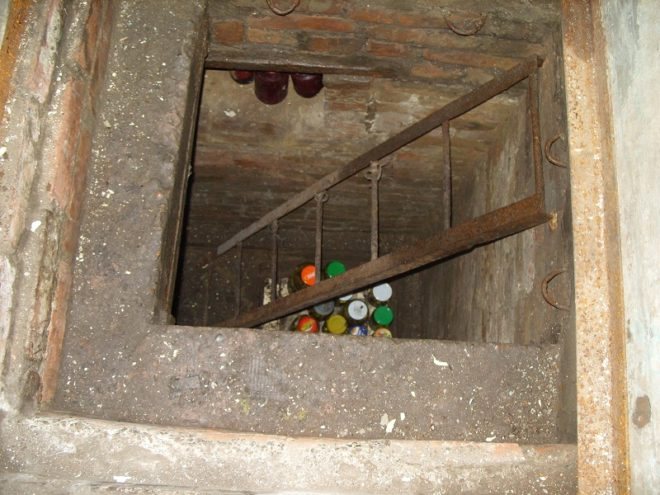

It is one of the most important structural elements of the basement, providing convenience and safety.
Constructions of 2 types are made:
- Ladder made of wood or steel elements;
- Marching - they install a ready-made reinforced concrete structure or occasionally pour it out of concrete.
When making a ladder, you need to remember a few rules:
- The width of the structure should be within 70-90 cm;
- The free space between the ceiling and the stairs in the lower part should be at least 1.9 m - this way you will eliminate the possibility of hitting your head on the ceiling;
- The slope of the marching structure is 22-75 degrees, for attached products - 45-75 degrees;
- It is necessary to make steps 25-32 centimeters wide. If they are made wider, then it will be inconvenient to climb, and narrow steps will make the descent risky;
- Convenient step height - 12-22 cm.
Ventilation device
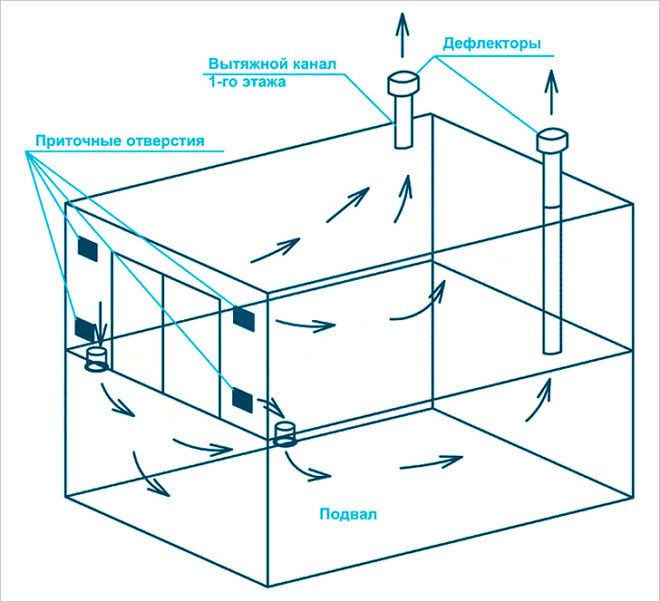

An efficient ventilation system will remove odors and moisture from the basement in the garage. Thanks to this, you can increase the storage period of winter stocks.
In basements, 2 types of these systems are used:
- Natural. An efficient and free-to-use design, if it is possible to provide an unimpeded supply of fresh air;
- Forced. Requires installation of a fan, but is suitable for any building.
Natural ventilation
The cost of a natural ventilation device is minimal, and it is easy to do it yourself:
- An exhaust pipe is mounted under the ceiling, its upper edge should be 50 cm higher than the top point of the garage roof. It is necessary to remove air from the basement;
- A supply pipe is installed above the floor surface of 7-10 cm and is led through the wall outside the garage. It is necessary for fresh air to enter the cellar;
- The edges of these tubes are protected with nets, they will not allow insects and debris to enter the basement. Small covers are mounted on top to protect against snow and rain.
In winter, natural ventilation sometimes does not work well because the openings can be blocked by frost. To prevent this trouble, the pipes are insulated and occasionally cleaned of snow adhering to them. To facilitate cleaning, the air duct exits are made detachable.
Forced exhaust
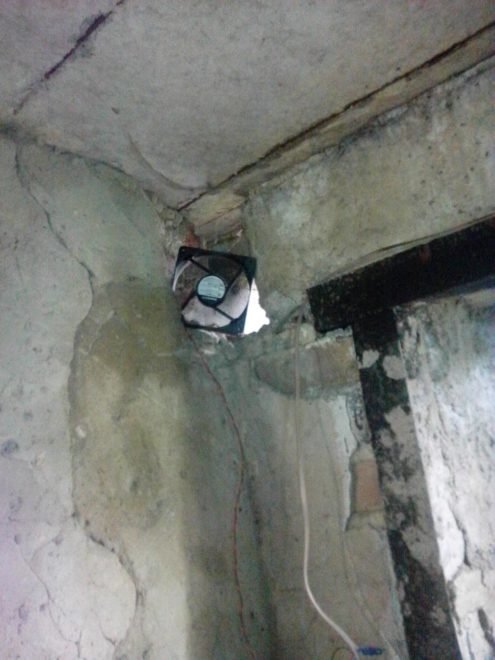

This system features an installed electric fan that blows air from the garage to the outside. Fresh air enters through another pipe or through a garage door.
A fully mechanized system can be installed to ventilate the basement. You will need to buy and install a monoblock running software, but it will not be cheap.

